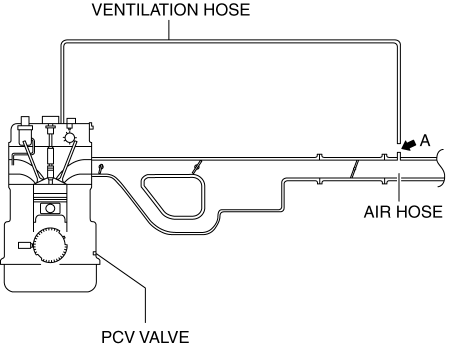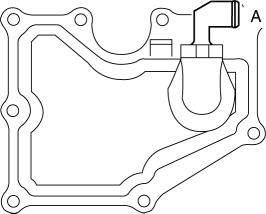Mazda 3 Service Manual: Positive Crankcase Ventilation (PCV) Valve Inspection [Mzr 2.0, Mzr 2.5]
Airflow Inspection
1. Disconnect the section (A) of the ventilation hose shown in the figure.

2. Start the engine and verify that vacuum is applied to the end of the disconnected ventilation hose while the engine is idling.
NOTE:
-
Because it is difficult to directly inspect the PCV valve, determine the integrity of the PCV valve by performing a simple inspection of the ventilation hose airflow condition.If the PCV valve is operating normally, vacuum occurs in the ventilation hose, however, if there is a malfunction in the PCV valve, positive pressure occurs in the ventilation hose because the blow-by gas is circulated to the air hose from the ventilation hose.
-
Verify the ventilation hose vacuum using the following methods:
-
When the tip of your finger touches the end of the ventilation hose, it is suctioned by the hose.
-
When a thin scrap of paper contacts the end of the ventilation hose, it is suctioned by the hose.
3. If it can be verified that vacuum occurs in the ventilation hose, the positive crankcase ventilation (PCV valve) system is determined to be normal.
-
If positive pressure occurs in the ventilation hose, perform the procedure from Step 4 to examine the PCV valve.
4. Remove the battery cover..
5. Disconnect the negative battery cable..
6. Remove the intake manifold and the fuel distributor component as a single unit..
7. Remove the PCV valve and the oil separator as a single unit..
8. Verify that there is no airflow when pressure is applied to port A.

-
If there is airflow, replace the PCV valve..
9. Verify that there is airflow when vacuum is applied to port A.
-
If there is no airflow, replace the PCV valve..
 EGR Valve Removal/Installation [Mzr 2.0, Mzr 2.5]
EGR Valve Removal/Installation [Mzr 2.0, Mzr 2.5]
1. Remove the battery cover..
2. Disconnect the negative battery cable..
3. Drain the engine coolant from the radiator..
4. Remove the air cleaner and the air hose as a single unit..
5. Remove ...
 Positive Crankcase Ventilation (PCV) Valve Removal/Installation [Mzr 2.0, Mzr
2.5]
Positive Crankcase Ventilation (PCV) Valve Removal/Installation [Mzr 2.0, Mzr
2.5]
1. Remove the battery cover..
2. Disconnect the negative battery cable..
3. Remove the intake manifold and the fuel distributor component as a single
unit..
4. Remove in the order indicated in ...
Other materials:
Oil Pump Removal/Installation [Skyactiv G 2.0]
WARNING:
Hot engines and engine oil can cause severe burns. Turn off the engine and
wait until it and the engine oil have cooled.
A vehicle that is lifted but not securely supported on safety stands is dangerous.
It can slip or fall, causing death or serious injury. Never work ...
Master Cylinder Removal/Installation [Mzr 2.0, Skyactiv G 2.0, Mzr 2.5]
1. Remove the battery and battery tray..
2. Remove in the order indicated in the table.
3. Install in the reverse order of removal.
1
Brake fluid level sensor connector
2
Reserve hose (MTX)
(See Reserve Hose (MTX) Removal Note.)
(Se ...
HVAC SST
49 B061 014
Spring Lock Coupling Disconnect Tool
49 G061 001
Spring Lock Coupling Disconnect Tool
49 B061 015A
Holder
49 0839 425C
Bearing puller set
49 SE01 160 ...
